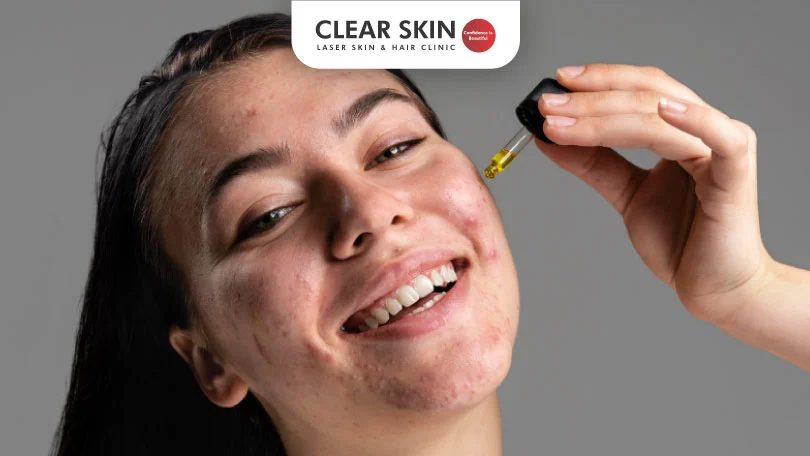Salicylic Acid: Your Ultimate Guide to Banishing Acne Scars
Reviewed By: Dr. Dhanraj Chavan
Updated on: 29th March, 2025

Are you tired of fighting the constant reminders of previous breakouts on your skin? Acne scars that appear to have taken up permanent residence can be frustrating. But don’t worry, there is a powerful ingredient to remove acne scars: Salicylic Acid!
Acne scars come in different shapes and sizes, from pitted scars to hyperpigmentation, and they can affect not just your skin but also your self-esteem. That is why it is critical to treat them effectively. Salicylic Acid is a powerful exfoliant that helps in removing acne scars, promising brighter, smoother, and scar-free skin.
In this guide, we will learn the effectiveness of Salicylic Acid for acne scars and hyperpigmentation. We will also find some very useful tips on how to use it.
Let’s get started!
Table Of Content
- What is Salicylic Acid?
- How Does Salicylic Acid Work on the Skin?
- Is Salicylic Acid Suitable for All Skin Types?
- Tips to Use Salicylic Acid Safely and Effectively
- The Effect of Salicylic Acid on Acne Scars
- Does Salicylic Acid Remove Acne Scars?
- How Long Does It Take for Salicylic Acid to Work on Acne Scars?
- Salicylic Acid and Hyperpigmentation
- Can Salicylic Acid Fade Hyperpigmentation?
- How to Use Salicylic Acid for Scar Treatment?
- Before and After: Salicylic Acid Scars Transformation
- Other Acids for Acne Scars: Which Acid Is Best for Acne Scars?
- Conclusion
What is Salicylic Acid?
Before moving forward with the effectiveness of salicylic acid for various types of acne scars, first understand what salicylic acid is.
Salicylic acid, a beta hydroxy acid (BHA), is commonly used in skincare to treat acne and other skin concerns. Derived from willow bark or synthetically produced, it is oil-soluble, allowing it to penetrate deep into the skin, dissolve excess sebum, and exfoliate dead cells. This makes it highly effective for treating acne, blackheads, and whiteheads.
Additionally, salicylic acid has anti-inflammatory and antibacterial properties that help reduce redness and swelling. It is available in various over-the-counter (OTC) products like cleansers, toners, serums, and masks, as well as prescription-strength formulas for more severe acne cases.
How Does Salicylic Acid Work on the Skin?
Salicylic acid is commonly used in skincare products to exfoliate the skin and treat acne. Let’s see how it works.
Acne develops when an excess of sebum (skin oil) and dead skin cells clog skin pores. This congestion can also entrap bacteria, resulting in inflammation and the formation of pus-filled pimples. When a pimple heals, it can leave behind a scar. This is because the damage to the skin can cause the production of collagen, which is a protein that helps to repair the skin. However, too much collagen can lead to the formation of a scar.
Salicylic acid is a natural and effective exfoliant that permeates the skin and actively dissolves the sebum that blocks your pores.
Is Salicylic Acid Suitable for All Skin Types?
Will salicylic acid remove scars from all skin types? It is the major concern of people using it. Let’s get answered.
Salicylic acid is generally considered safe for all skin types but is especially beneficial for oily and acne-prone skin. Salicylic acid can help people with combination skin, which is both oily and dry in different regions, especially if they have oily zones or are prone to blocked pores.
Oily Skin:
Salicylic acid can help to reduce oil production and unclog pores, which can help to prevent and treat acne.
Dry Skin:
Salicylic acid can help exfoliate the skin and remove dead skin cells, revealing brighter, smoother skin.
Sensitive Skin:
Salicylic acid is generally considered safe for sensitive skin, but it is important to start with a low concentration and use it less often.
Combination Skin:
Salicylic acid can be used to treat oily and acne-prone areas of the face while also exfoliating and smoothing dry regions.
However, if you have dry or sensitive skin, you need to be more cautious when using salicylic acid on scars, as it can exacerbate dryness and irritation. Other possible side effects of Salicylic acid may include:
- Mild burning
- Stinging
- Skin peeling
- Hives
Tips to Use Salicylic Acid Safely and Effectively
So if you have sensitive skin, follow the below tips to use salicylic acid safely and effectively:
- It is best to start with a low concentration of salicylic acid and gradually increase the concentration as your skin tolerates it.
- Do a patch test by applying salicylic acid on a small skin area before using it on your entire face.
- Don’t use it on sensitive areas and broken skin to avoid irritation.
- Use moisturizer after applying salicylic acid.
- If you experience any side effects, stop using salicylic acid and consult your dermatologist immediately.
Note: Although topical salicylic acid is safe in pregnancy or nursing, you should consult a doctor/dermatologist before using salicylic acid.
The Effect of Salicylic Acid on Acne Scars
Salicylic acid can improve the appearance of acne scars through its exfoliating and skin-renewing properties.
Salicylic acid for acne scars penetrates the skin and stimulates the shedding of dead skin cells, excess oil, and dirt that can contribute to the appearance of acne scars when administered topically. This exfoliating procedure helps unclog pores and increases cell turnover, enabling fresh, new skin cells to appear.
Salicylic acid’s exfoliating effect also helps to reduce hyperpigmentation left behind by acne lesions in the case of acne scars. Salicylic acid can progressively lessen the appearance of dark spots and uneven skin tone caused by earlier acne outbreaks by stimulating the shedding of damaged and discoloured skin cells.
Also, the capacity of salicylic acid to decrease inflammation can help to improve the look of acne scars. It can make scars less visible and benefit a more even complexion by relaxing the skin and reducing redness and inflammation.
Does Salicylic Acid Remove Acne Scars?
Salicylic acid is commonly used in skincare products to exfoliate the skin and treat acne. Let’s see how it works.
Acne develops when an excess of sebum (skin oil) and dead skin cells clog skin pores. This congestion can also entrap bacteria, resulting in inflammation and the formation of pus-filled pimples. When a pimple heals, it can leave behind a scar. This is because the damage to the skin can cause the production of collagen, which is a protein that helps to repair the skin. However, too much collagen can lead to the formation of a scar.
Salicylic acid is a natural and effective exfoliant that permeates the skin and actively dissolves the sebum that blocks your pores.
How Long Does It Take for Salicylic Acid to Work on Acne Scars?
Salicylic acid typically shows its effectiveness against active acne within just a few days of use.
However, the time it takes for salicylic acid to work on acne scars can vary from person to person, depending on several factors, including the type and severity of the scars, as well as individual skin characteristics.
With a regular skincare routine, you can expect to notice an improvement in the appearance of salicylic acid acne scars within approximately four weeks.
Here is a general timeline for seeing results with salicylic acid for different types of acne scars:
- For mild acne scars, such as superficial scars and post-inflammatory hyperpigmentation, you may notice small changes within a few weeks with constant use. However, it can take 2 to 3 months to show the more significant results.
- Deeper acne scars like icepick scars or boxcar scars may take 3 to 6 months or even longer for improvement.
It is essential to be patient and consistent with your treatment to see the final results of the treatment. If you have any concerns about using salicylic acid for acne scars, we are here to help you.
Salicylic Acid and Hyperpigmentation
Hyperpigmentation occurs due to excess melanin and can result from sun exposure, acne, or hormonal changes. While there’s no universal treatment, salicylic acid is effective in fading dark spots and improving skin tone.
Salicylic acid penetrates the skin, loosens dead cells, and accelerates exfoliation by dissolving the bonds between them. As a peeling agent, it helps remove the upper skin layer faster.
Dealing with dark spots can be frustrating, but with patience and regular use, salicylic acid can help you achieve a more even, radiant complexion.
Can Salicylic Acid Fade Hyperpigmentation?
Yes, salicylic acid can help fade hyperpigmentation by exfoliating the skin, removing dead cells, and revealing brighter skin. This beta hydroxy acid (BHA) also reduces dark spots and has anti-inflammatory properties that soothe redness and irritation.
Studies suggest salicylic acid is effective in treating melasma, a common type of hyperpigmentation. It can also help reduce sun spots when used correctly. However, it’s important to choose the right concentration, do a patch test for sensitive skin, and always wear sunscreen to prevent sun sensitivity.
How to Use Salicylic Acid for Scar Treatment?
Now, you might be wondering how to use salicylic acid for acne scars treatment. Don’t worry! Here, we will share some tips to incorporate salicylic acid into your skincare routine for scar reduction.
Salicylic acid products such as cleansers, toners, face wash, creams, and medicated acne pads come in various concentrations, so start with a low one and gradually increase it as your skin tolerates it. A cleanser or toner containing 2% salicylic acid is an excellent starting point.
Here are the steps to use salicylic acid for acne scar treatment:
-
- Clean the affected area with a mild cleanser and pat dry.
- Apply a thin layer of salicylic acid to the affected area once or twice a day.
- You can use a salicylic acid cleanser, toner, cream, or gel.
- Allow the salicylic acid to dry completely before applying any other skincare products.
- Use a Moisturizer After Applying Salicylic Acid. Salicylic acid can dry out the skin, so it is important to use a moisturizer after applying it.
Important Notes:
-
- Wear sunscreen with an SPF of 30 or higher during the day when using salicylic acid products, as it can make your skin more sensitive to the sun.
- If you experience any irritation, stop using salicylic acid immediately.
- Keep your treatments regular and patient. It might take weeks or months to see visible improvements.
Scarring can be a challenge, but there are ways to treat and manage them. One of them is salicylic acid. It is a safe and effective treatment for many types of scars. If you have any questions or concerns about the concentration of salicylic acid for acne scars, please talk to your dermatologist.
Before and After: Salicylic Acid Scars Transformation
Salicylic acid for acne scars effectively removes the appearance of scars by exfoliating the skin, reducing inflammation, and stimulating collagen production. It can also help improve the skin’s overall appearance by making it smoother and more even-toned.
However, a higher concentration of salicylic acid can irritate the skin, especially sensitive skin, so it is important to choose a product with the right concentration for your skin type and to moisturize after use.
Other Acids for Acne Scars: Which Acid Is Best for Acne Scars?
| Acid | Type | Benefits | Drawbacks |
|---|---|---|---|
| Salicylic Acid | BHA | Penetrates deep into pores to remove dirt, oil, and dead skin cells and reduces inflammation | Can be drying and irritating to sensitive skin |
| Glycolic Acid | AHA | Exfoliates the surface of the skin to remove dead skin cells and promote cell turnover; evens out skin tone and texture | Can be irritating to sensitive skin |
| Lactic Acid | AHA | Exfoliates the surface of the skin to remove dead skin cells and promote cell turnover; is more gentle than glycolic acid | Can be less effective than glycolic acid for deep acne scars |
| Mandelic Acid | AHA | Exfoliates the surface of the skin to remove dead skin cells and promote cell turnover; is less irritating than glycolic acid and lactic acid | Can be less effective than glycolic acid and lactic acid for deep acne scars |
| Azelaic Acid | Naturally occurring acid | Reduces inflammation and hyperpigmentation; is gentle on the skin | Can be less effective than other acids for deep acne scars |
| Kojic Acid | Naturally derived acid | Known for its ability to lighten skin tone. Effective in treating acne scars, hyperpigmentation, and melasma. | Can be irritating to the skin, especially at high concentrations. |
| Hyaluronic Acid | Naturally occurring acid | Reduces inflammation, Effective in treating acne scars | Can cause skin irritation, such as redness, itching, or burning |
Do You Know?
Roughly 250 Patients Are Treated
Everyday By These Dermatologists
(You are one click away from flawless skin)
Meet Our Dermatologist!
Conclusion
Salicylic acid helps treat acne scars by exfoliating the skin, reducing inflammation, and boosting collagen production. However, improper use may cause irritation, especially for sensitive skin. Consulting a dermatologist is crucial for the best treatment approach. At Clear Skin Clinic, Pune, our experts guide you in choosing the right treatment for your skin. Book your consultation today!
Further Reading
How to Avoid Acne in Monsoons?
Avoid acne in monsoons with a gentle skincare routine, diet tips, and hydration. Get expert advice to manage breakouts and keep your skin clear and healthy.
Does Makeup Cause Acne-Prone Skin?
Worried about breakouts from using makeup? Does makeup cause acne for you? Learn the safe ways to apply makeup for acne-prone skin.
Morning Skin Care Routine for Glowing Skin
Clear Skin Clinic, led by top dermatologists, shares the ideal morning skincare routine to help you achieve a radiant complexion naturally and effectively.
Monsoon Skin Care Tips for Radiant, Healthy Skin
Clear Skin Clinic, led by top dermatologists, shares the ideal morning skincare routine to help you achieve a radiant complexion naturally and effectively.
Have thoughts? Please let us know
We are committed not only to treating you, but also educating you.





